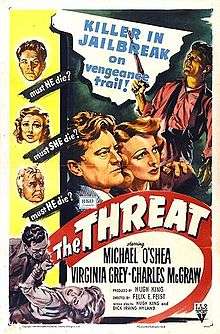The Threat (film)
| The Threat | |
|---|---|
 Theatrical release poster | |
| Directed by | Felix E. Feist |
| Produced by | Hugh King |
| Screenplay by |
Dick Irving Hyland Hugh King |
| Story by | Hugh King |
| Starring |
Michael O'Shea Virginia Grey Charles McGraw |
| Music by | Paul Sawtell |
| Cinematography | Harry J. Wild |
| Edited by | Samuel E. Beetley |
| Distributed by | RKO Radio Pictures |
Release dates |
|
Running time | 66 minutes |
| Country | United States |
| Language | English |
The Threat is a 1949 American film noir directed by Felix E. Feist and starring Charles McGraw. The film features Michael O'Shea, Virginia Grey, and Charles McGraw.[1]
Plot
Detective Ray Williams (Michael O'Shea) is recuperating from a broken rib as his wife Ann (Julie Bishop) tries to persuade him to get a desk job, especially with the new baby on the way. However, a call from the police inspector (Robert Shayne) informs him that homicidal criminal "Red" Kluger (who Williams apprehended) has busted out of Folsom Prison. As Williams is going to leave in his police car, he is kidnapped by Kluger (Charles McGraw) and his men. District attorney Barker MacDonald (Frank Conroy) is also kidnapped by his men. Lastly, nightclub singer Carol (Virginia Grey), who apparently ratted him out is kidnapped. She however claims it was Tony, one of Kluger's associates, who Red has arranged to come out of Mexico City to Palm Springs to give Red and his associates the $12,000 from a deposit box and give them an escape plane to leave the country out of. Kluger makes no secret of his plans to kill Williams and MacDonald once he's made a getaway. Carol claims to not have ratted him out constantly, but Kluger rejects her claims. Kluger also takes in another hostage, Joe Turner, driver of the truck escorting the gang. The gang is housed up at a shack, awaiting Tony. Joe tries to escape with a gun he had stolen from the truck earlier, but Kluger subdues him, takes the gun and kills him.
Ray is forcefully told by the gang to give the police a false lead on the radio to throw them off. Inadvertently, he tips off his wife that he may be in danger by saying to tell his wife the newborn kid can be named Dexter, which his wife finds suspicious due to his previous statements that he'd name the newborn Dexter only if he'd had a gun to his head. Kluger tells Lefty and Nick to force Williams to call off the search for him, but Williams and MacDonald subdue and tie up the henchmen. They call out to Kluger to come to them, awaiting to try and shoot him, but in the ensuing gunfight, Kluger shoots Ray in the knee. Williams decides to climb up the wall and hang over the door, as MacDonald tries to bait Kluger to come to them. As he walks over to the door, Ray jumps up and lands on Kluger, but Kluger overpowers him and hits him with a chair. Kluger goes outside to see that a plane with Tony is nearby, waving to him to land. However, as he comes back inside, he sees that Carol has a gun. Telling her to drop the gun, he yells at her to not shoot, but Carol shoots him twice, killing him. Ray gets up and thanks her, while saying that he will deal with Tony.
The film ends with Williams discussing with Ann over the naming of their kid, and she reveals that one can be Dexter - because they're having twins.
Cast
- Michael O'Shea as Detective Ray Williams
- Virginia Grey as Carol
- Charles McGraw as Arnold "Red" Kluger
- Julie Bishop as Ann Williams
- Frank Conroy as District Attorney Barker MacDonald
- Robert Shayne as Inspector "Murph" Murphy
- Anthony Caruso as Nick Damon
- Don McGuire as Joe Turner
- Frank Richards as Lefty
- Michael McHale as Detective Jensen
Reception
Critical response
When released The New York Times gave the film a positive review, writing, "...[the film is] reasonably well written...[and] Charles McGraw is first-rate as the gravel-voiced, square-jawed, ruthless gangster, while Michael O'Shea, Virginia Grey and Frank Conroy chip in with adequate portrayals of the cop, district attorney and gangster's moll. Crime, after all, does not pay, but Mr. McGraw can make it diverting."[2]
References
- ↑ The Threat at the TCM Movie Database.
- ↑ The New York Times. "Cops and Killers on Scene Again," film review, December 2, 1949. Last accessed: December 10, 2007.
External links
- The Threat at the American Film Institute Catalog
- The Threat at the Internet Movie Database
- The Threat at AllMovie
- The Threat film scene on YouTube